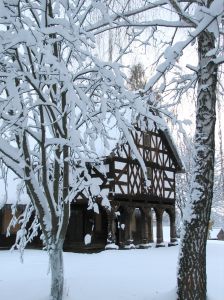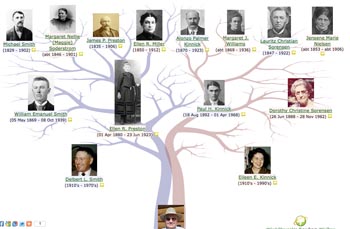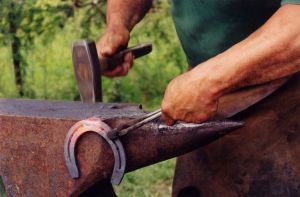Creating a Family Saga - FS3 - Creating the Relationships
Could you base your family saga around this tavern?

Introduction - Relationships are the heart of a family saga
I grew up on a farm 7 miles from a small rural farming community in west central Iowa. My father was born and grew up a couple of miles to the west. My mother was a “town-girls” and “banker’s daughter” - her descriptions - although she became a good example of “farm wife” for many, many years. Neither of them ever lived anywhere else. They took vacations around the nation, eventually, but never lived anywhere except within a few miles of this one community. As I grew up, with my four younger brothers, I gradually became aware that I was related to, by blood or marriage, a very high percentage of the people I encountered in this community. I went off to college, and never returned to live there… although we continued to visit regularly… and, I have continued to get a subscription to the local weekly newspaper (now online, by the way).
Relationships, then, in my view, are at the very heart of any stories of the community and of the families that make up community; that make up family sagas. As the years went by, and my wife and I got heavily into family history and genealogy research, we learned even more about how inter-related those relationships in our small hometown community were. Her background was similar to mine. Her parents were guests in my parents home during the month between my birth and her birth - according to my mother’s diary. Although we have determined we are not blood-related, there are a number of folks in our hometown to whom we are each blood-related, and many, by marriage, of course. This has always fascinated me, and have become part of the inspiration for my family saga stories.
Two related issues coming out of mutual family history and genealogy research have informed and contributed to my interest in relationships. We each, early on, found that doing research on the mother’s lines - not just the paternal line, which has been so common in the past - while more difficult, was also most rewarding. The second related issue comes out of this - aunts and uncles played vital roles in families… most often, aunts and uncles on the mother’s side of the family. More on this later. Just wanted to get it mentioned here, for background.
In the next section, I’ll continue to show how family relationships are at the heart of family sagas. In the last section, we’ll look at non-family relationships and demonstrate how critical they are, also, to creating realistic family saga stories.
Video Book Trailer
My four generation family tree

Family relationships form the framework for family saga stories
Families in a small rural community, where I prefer to set family saga stories, are typically at least three generations, occasionally four generations, and possibly five generations. [My “The Homeplace Saga” stories have now extended from five to seven generations, but that is probably considered unusual.] The same applies to all settings, of course. To keep our discussion manageable, let’s just consider three generations, right now: grandparents, parents, and children. However, each grandparent may have one or more brothers or sisters. Each of them may well be married, and have children of their own. The generation I labelled as “parents” likely has one or more brothers and one or more sisters, who may be married, creating the aunts and uncles to whom I referred earlier. Their children, of course, are the first cousins of our original “children” - grandparents are the common ancestors, the definition of first cousins. Did you grow up with several first cousins around, as best friends, as we did? Of course you did. So, already, we have the primary basis of our family saga.
In writing family saga stories, the first challenge may well be limiting the number of family members we can possibly include in our stories. Whereas our true ancestors, a few generations back, typically had 10-12 children, it becomes very difficult to handle more than 3-4 in our stories. Exceptions can be made, but must be handled carefully. One of my McDonald families in my Founding stories in “The Homeplace Saga” had six children prior to the Civil War. But, two were “killed off” in the Civil War, and two were youngsters, so my stories mostly focused on the other two as key characters, the oldest daughter and a middle son.
Particularly during the 19th century, it was quite common for children to be “farmed out” to the home of a brother or sister of one of the parents - those aunts and uncles mentioned earlier - often the mother’s married brother or sister. Occasionally, this was a couple with no children. On the farm, a nephew or niece could be very helpful to them. In my research, I came across a number of these that not only solved a puzzle as to where the child was, but also became a good story to share.
A blacksmith was among the first 11 settlers

Non-family relationships fill in the context of family sagas
To be, and appear to be, realistic, family sagas also need those stalwarts of the community, the banker, the grocer, the tavern owner, the lawyer, the sheriff, the teamster, the blacksmith, and so forth, depending on the community you have created. All of the essential persons to make a community work cannot reasonably be relatives. In addition, you need non-related families to provide the brides and grooms for your blood-related family members to court and marry. First cousins have married throughout history, but they are the exceptions, not the norms. More often, blood related matches are of the third cousin, once removed, type of relationships. But, you don’t want too many of those in your stories, either. And, when you do, there needs to be a proper foundation laid for including it.
All these things being said, we now have a grasp of the various relationships that will build a quality set of interconnected families for a viable community. People can live, and interact, in normal and natural ways, through their daily activities, meet new people, and choose their future mates and reject others with whom they are not compatible. Family sagas generally will span several generations, but with these elements there will never be a lack of useful “material” for your stories.
In “The Homeplace Saga” I first wrote a story based in 1987 that was based on a couple with four children raised on a farm that had been in her family for over 150 years. Three of the four children had moved to other states as they grew their own families. That first novel, “Back to the Homeplace,” brought them all back to the home farm. For subsequent books, to fill in their background, based on this family and their interconnected relatives, neighbors, and friends, I took the story back over 150 years to the first 11 person settlement party in their rural southern Missouri Ozarks farming community and reconstructed the several generations of community lives connecting them. You may not think you want to get that elaborate with your story… but, you may also be surprised to find that you really want to. So, in that case, just do it. It is actually quite fun. Or, at least, it was for me.
*** to be continued *** see forthcoming FS 4 ***
Direct links to two preceding articles in this series
- Creating a Family Saga | FS2 | Creating the families
This article describes how the original families of "The Homeplace Saga" were created and put in place in the context of the first novel and the story of The Founding. Constraints are discussed. - Creating a Family Saga | FS1 | Creating the Village
Background information on the creation of a multi-year, multi-family family saga work of historical fiction over a number of years. First of a series. Maps and adding people discussed here.






